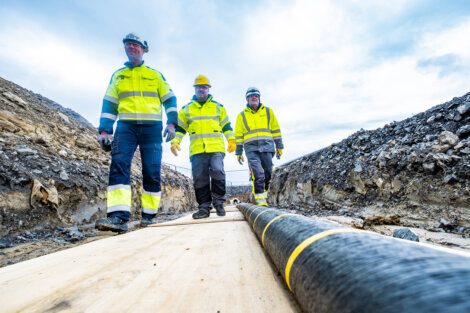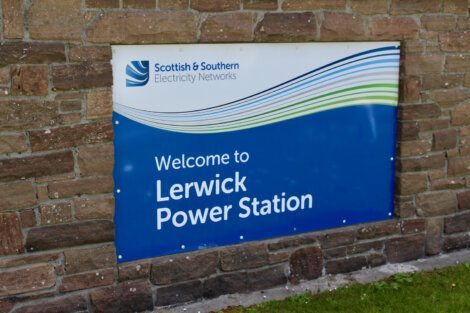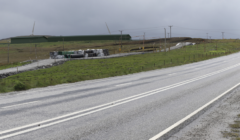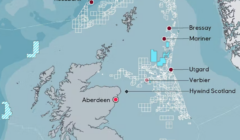Energy / Prospect of more subsea links to mainland raised as SSE looks to the future
SSEN has raised the possibility of more subsea cables being built to link Shetland to the UK mainland as a result of anticipated energy production and demand.
A 600MW HVDC transmission link has already been laid by the company between Shetland and Caithness ahead of the Viking Energy wind farm going live later this year.
It will power to be exported to the national grid, and also allow import into Shetland.
But in newly released documents about the future energy set-up in Shetland, SSEN said possible future renewable production and power demand through offshore wind, hydrogen electrolysis and oil and gas platform electrification mean Shetland will need more routes of supply in the decades ahead.
It has also confirmed that it will now be November 2025 when the diesel fired Lerwick Power Station goes into standby mode and Shetland’s needs are met by renewable energy and the grid.
SSEN says that a second transmission link could help to provide back-up capabilities in the years ahead when the proposed 70MW battery storage system in Lerwick reaches the end of its “asset life”.
This battery storage would go live if there is an outage on the cable to keep Shetland’s supply going whilst Lerwick Power Station comes out of standby mode.
SSEN has has now submitted an application to energy regulator Ofgem for final approval of the standby service solution.
In February the Scottish Government gave the battery system planning consent.
The future standby solution, involving Lerwick Power Station and the battery storage system, is expected to cost £92.55 million over a ten-year period once energised, SSEN documents state.
The energy company also noted how since battery company Zenobe placed its bid for the storage solution contract in January 2023 to final negotiations in December, the anticipated costs have increased.
Become a member of Shetland News
However the finer details on this cost increase are redacted in the public document.
The documents also suggest SSEN is spending around £21 million year at the moment running Lerwick Power Station.
Looking to the future, from 2035 onwards, SSE has said a second interconnector would also reduce investment required at Lerwick Power Station because less back-up capacity would be required.
It said a second link could potentially be 1,800MW in capacity, or 600MW, and be operational from 2035.
There is also talk of a possible third link but there are no grounds for a needs case based on known developments at the moment.
SSE also said the huge cost of a second or third link cannot be justified by the power company alone and would require a “whole system approach” alongside other large customer connections.
A first decision point on the way ahead could come in the next 12 to 24 months.
The document highlights that in addition to the 443MW Viking Energy wind farm, three other wind farm developments in Shetland have consent with a total capacity of around 240MW.
It also says there is anticipated to be hydrogen electrolysis demand for power by 2028.
Also in the mix are proposed offshore wind farms to the east of Shetland, and a drive to reduce carbon emissions from the oil and gas industry by electrifying platforms – potentially through a cable from Shetland.
There may also be electrification demand for carbon capture projects, with Sullom Voe Terminal set to facilitate these.
Terminal operator EnQuest also revealed recently that it plans to shut down the site’s own power station in the future and instead run underground power cables from Lerwick.
A spokesperson for SSEN Distribution said: “The primary purpose of the standby solution is to keep the electricity flowing for all our customers in Shetland and this forms the service with SSEN Distribution.
“The provider of this standby solution, will, once this key need has been fulfilled, be able to generate additional revenue from spare capacity, for example during the summer when overall electricity demand in Shetland is lower.
“Although SSEN will have no direct role in any arrangement to utilise spare capacity, the approach with the service producer can mean that reductions in costs achieved by energy trading will be passed onto consumers at the end of the current price control period.”
Responding to the mention of possible future subsea links to the mainland, chairman of campaign group Sustainable Shetland Frank Hay said it is something for “certainly well into the future, and I very much doubt if that will happen”.
“Many of the plans into the future would necessitate colossal expenditure and, sooner or later, affordability must become a consideration. It is significant that Labour have now rolled back from their £28 billion annual commitment to such developments,” he said.
“Energy poverty would be highly likely to increase if such plans came to fruition, not to mention environmental issues that would need to be properly taken into account beforehand.”
Meanwhile the project director of the proposed 2.3GW Arven offshore wind farm to the east of Shetland, Ewan Walker, said recently that the National Grid is currently coordinating a “strategic exercise” to define where and when electricity from future offshore wind projects will land around the UK.
He said the outcomes are expected to be known in the next few months.
“With that in mind, Arven is still at a very early stage of planning so it is too early to say how the project will develop,” Walker said.
“However, with its exceptional wind resources and existing energy infrastructure, there is potential for hydrogen, ammonia, electrofuel production and other offtake opportunities – as well as grid connection – to help deliver Shetland’s energy transition.”
Become a member of Shetland News
Shetland News is asking its many readers to consider paying for membership to get additional features and services: -
- Remove non-local ads;
- Bookmark posts to read later;
- Exclusive curated weekly newsletter;
- Hide membership messages;
- Comments open for discussion.
If you appreciate what we do and feel strongly about impartial local journalism, then please become a member of Shetland News by either making a single payment, or setting up a monthly, quarterly or yearly subscription.


















































































